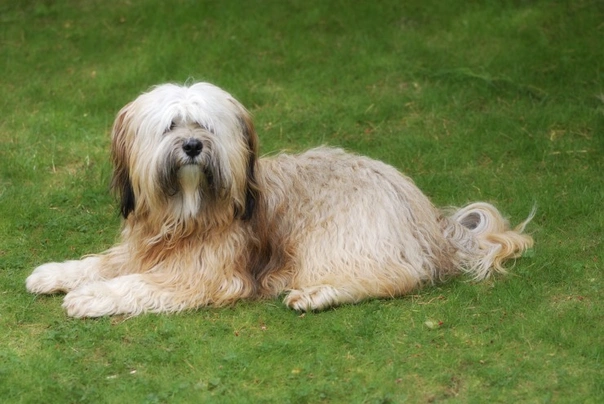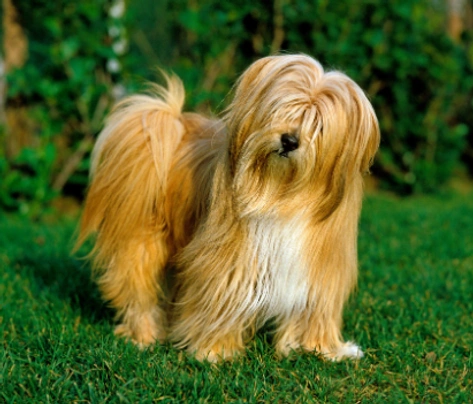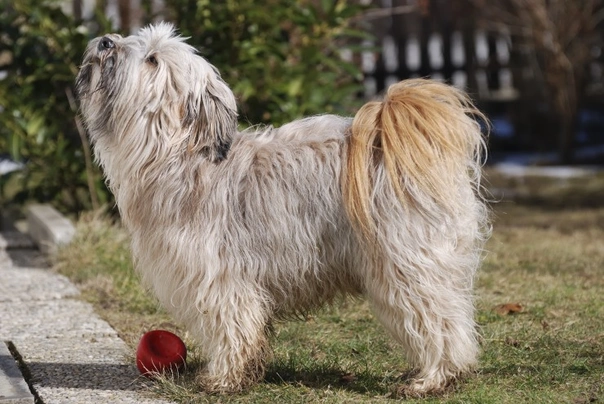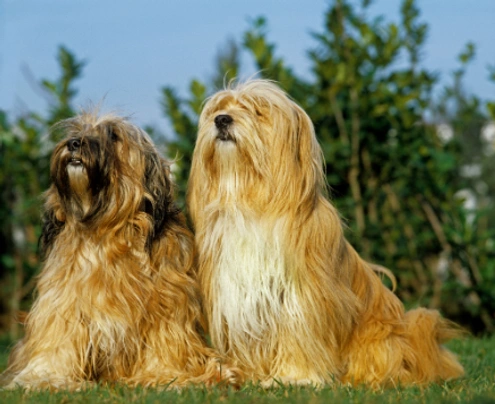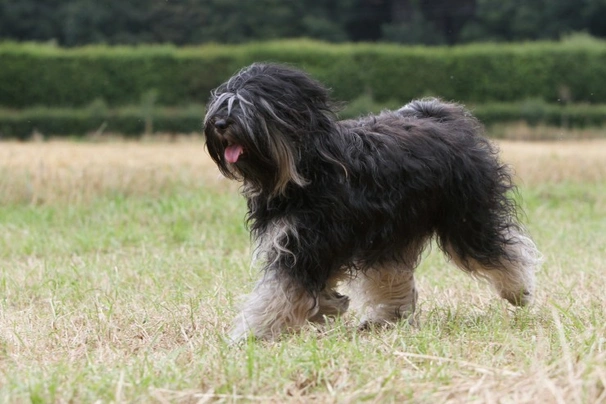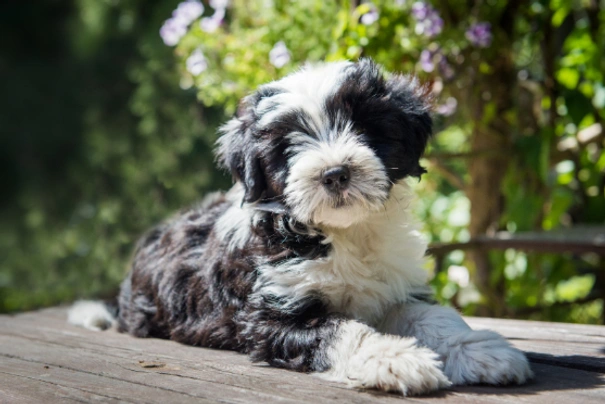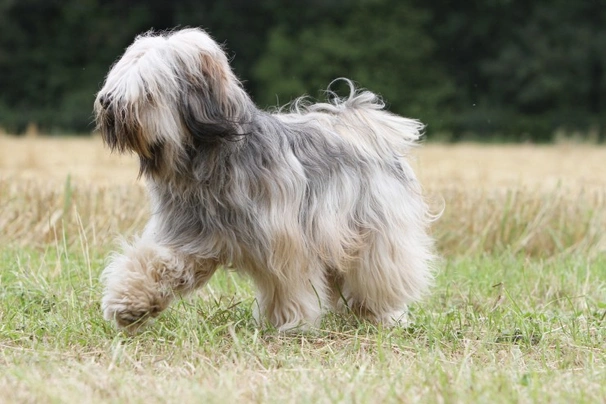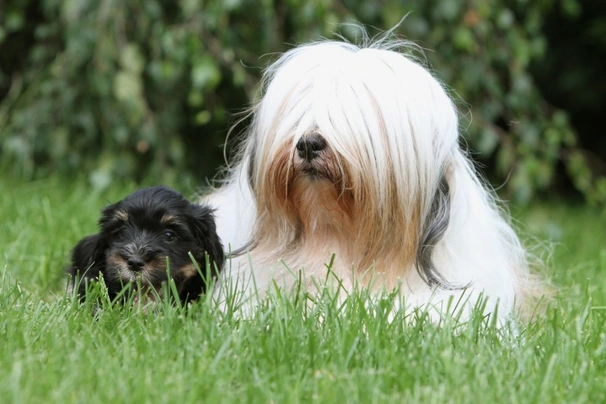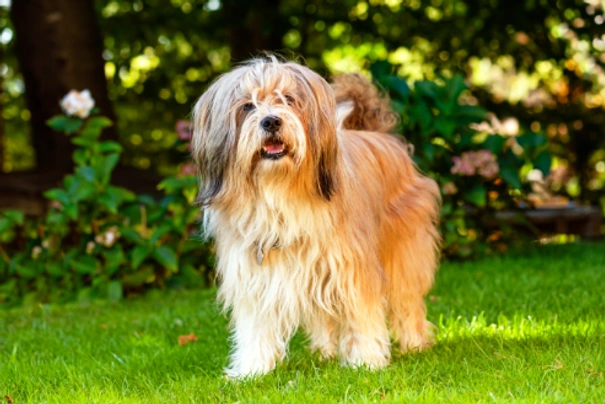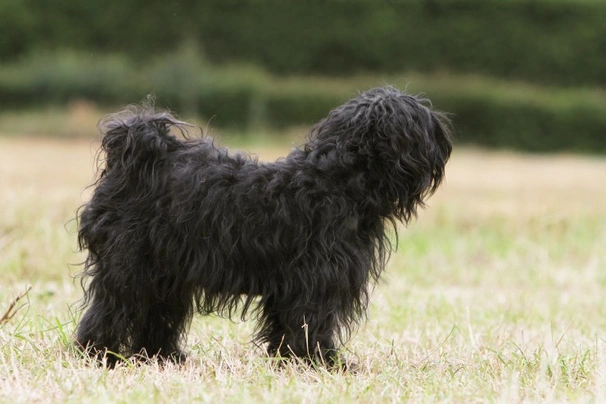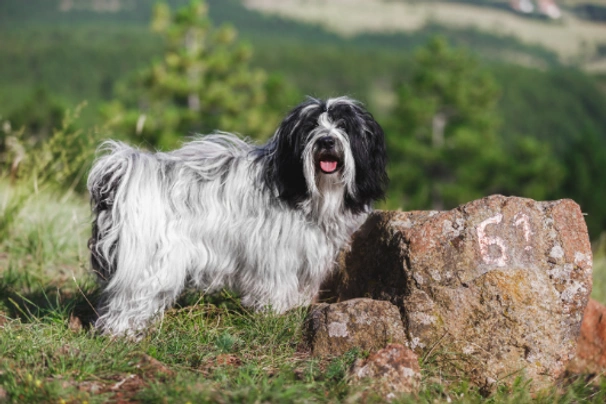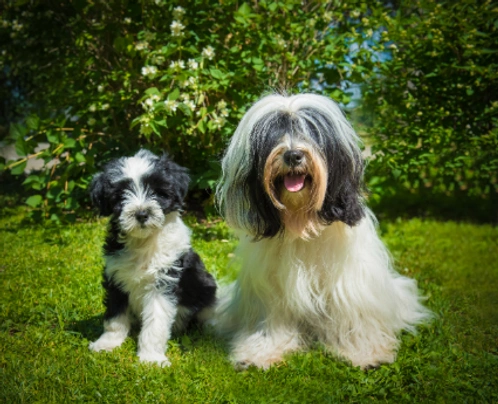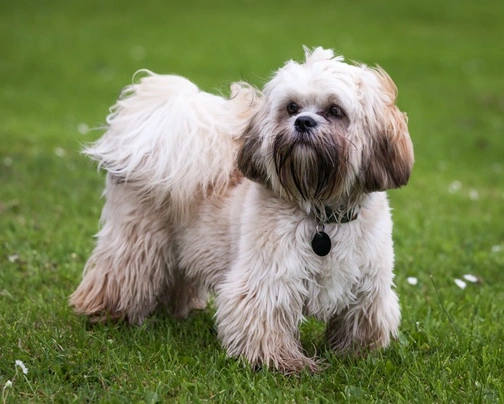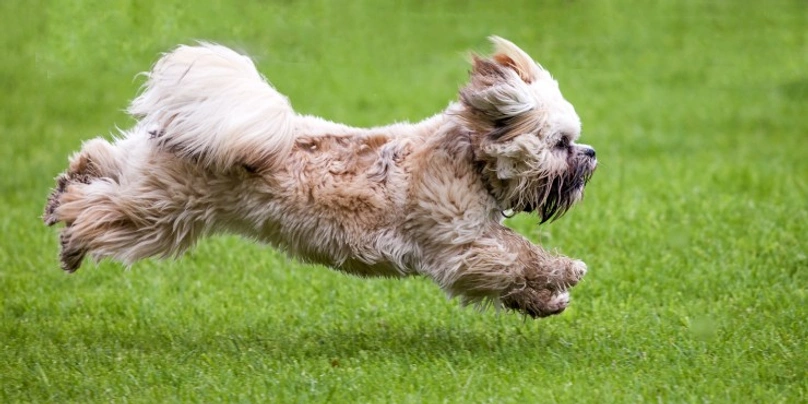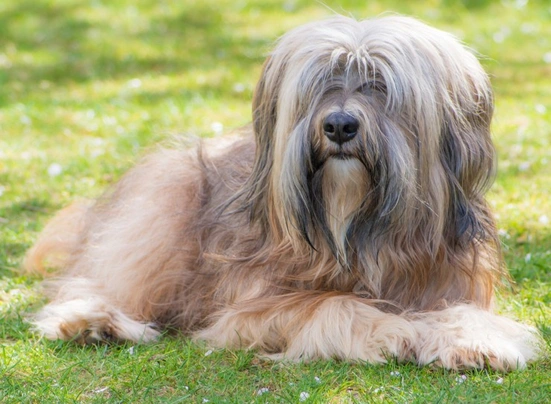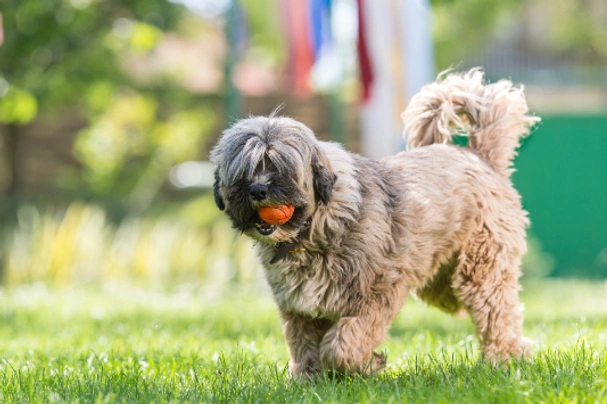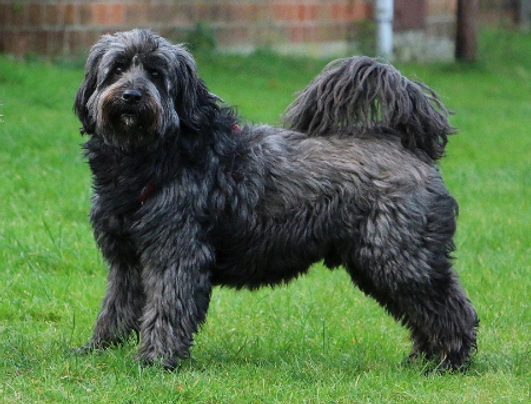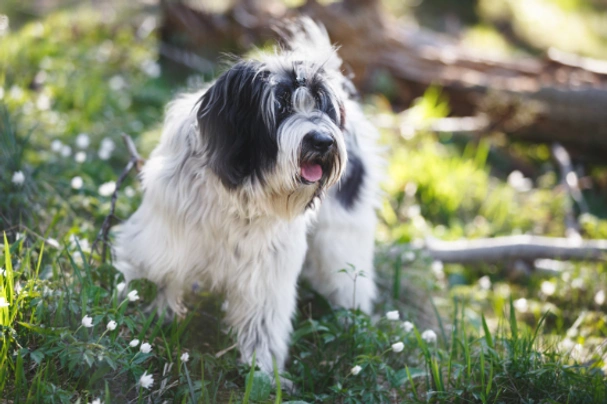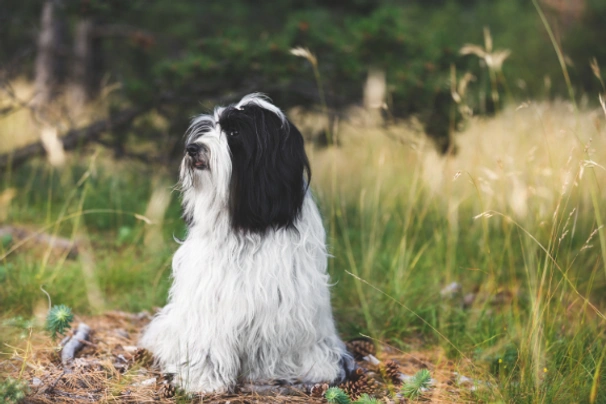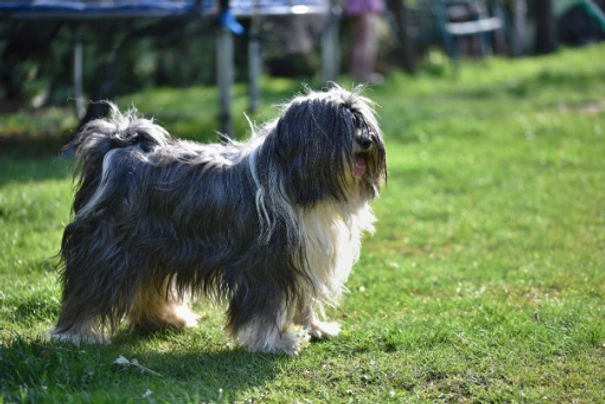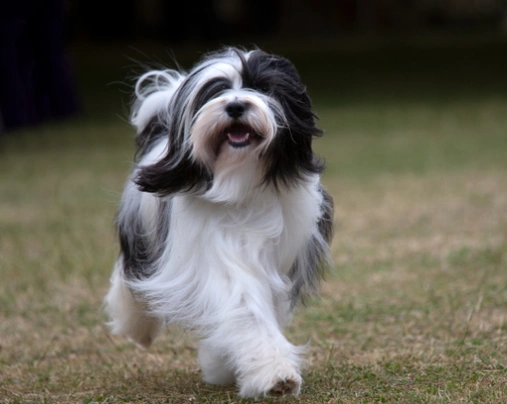Tibetan Terrier
Pros
Cons
Introduction of the Tibetan Terrier
Tibetan Terriers are known to be playful outgoing and lively characters that become totally devoted to their families while at the same time they are calm and never overly demanding. They are also highly adaptable being just as happy living in an apartment in town as they are living in a house in the country providing they are given lots of mental stimulation and vigorous daily exercise to prevent boredom from setting in which could lead to behavioural issues developing.
Tibetan Terriers were originally bred to herd flocks and to guard monasteries in the high regions of the Himalayan Mountains. They are thought to be the original Tibetan Holy Dog and are the tallest and liveliest of all the Tibetan dogs classed as Utility dogs by The Kennel Club. These charming dogs have gained a big fan base over recent years thanks both to their popularity in the show ring and in a home environment which is hardly surprising given their kind and loving natures. With this said anyone wishing to share a home with a well-bred healthy Tibetan Terrier might have to go on a waiting list for the pleasure of doing so because although they are a popular breed the number of puppies available every year remains quite low.
History of the Tibetan Terrier
The Tibetan Terrier was bred to be a hardy robust dog and one that could survive the harshest conditions of the high regions of the Himalayas. They are the tallest of all the Tibetan breeds and were used as guardians herders and companions to monks who lived in remote mountain monasteries. Nomads also used these charming loyal dogs as watchdogs when they made their epic journeys from China to Tibet and then back again. The breed is thought to be the original "Holy Dogs of Tibet" and all through the ages they have been highly prized by monks and families alike who treated their dogs are valued members of the family. Anyone who mistreated a Tibetan Terrier would be frowned upon and even ostracized from a community because these dogs were so highly thought of.
Tibetan Terriers were thought to be "bringers of luck" and were often offered to intrepid travellers as good luck charms on their journeys which often took them over challenging terrains. They were first discovered by an English doctor called Dr. Greig who lived in India during the 1920's and who was offered a puppy by a merchant she treated as a “thank you” for saving his wife's life. At the time Tibetan Terriers were never sold but they were offered as gifts to people. The Doctor called her puppy "Bunti" a name that was later changed to "Bunty".
The doctor was so enchanted by her dog that she asked if she could exhibit her at one of India's dog shows that was held in Delhi and it was during this time that the judges who had never seen a similar looking dog suggested she got a mate for her Bunty and to start a breeding programme as a way of establishing if her dogs bred "true" to type. She purchased a second Tibetan Terrier from the merchant which she named Rajah and began breeding from her two dogs. It was on Christmas day in 1924 that she produced her first litter of Tibetan Terrier puppies and a second litter was born the following year in July.
The doctor returned to the UK a year later in 1926 bringing her 3 Tibetan Terriers with her which included a female from her first litter called Chota Tuka and a male called Ja-Haz from the second litter. She continued her breeding programme with Bunty and in 1927 the first litter of Tibetan Terriers was born in the UK. Dr. Greig then took a male puppy from the litter called Mr. Binks back to India with her where he was awarded the first TT World Champion after having won four Challenge Certificates at a Dog Show.
The doctor also exhibited a Tibetan Terrier at Crufts Dog Show on a trip she made back to England. The dog was a white Tibetan Terrier called Thoombay of Ladkok that had been bred in a Tibetan monastery. He was to the first of the breed to be awarded the title of Tibetan Terrier English Champion when he was ten years old. Doctor Greig continued her breeding programme through the thirties and was a strong force behind getting the breed recognised by the Kennel Club although she was a keen advocated of ensuring the Tibetan Terrier was seen more as a "working dog" rather than a "show dog".
A Tibetan Terrier Club was founded in 1956 when a breed enthusiast called Constance Downey established the Luneville Kennel which promoted the breed during the fifties and sixties. However it was not until the 1970's that the Tibetan Terrier gained popularity in the UK which sadly was after the death of Doctor Greig who passed away in 1972. Many breed enthusiasts believe the Tibetan Terrier really made a mark on the UK and the world when a dog called Araki Fabulous Willy won Crufts Best in Show in 2007.
Today Tibetan Terriers are gaining popularity thanks to their charming looks and kind affectionate fun-loving and loyal natures with more well-bred puppies being registered with The Kennel Club every year although as previously mentioned anyone wishing to share a home with a Tibetan Terrier would have to go on a waiting list for the pleasure of doing so.
Interesting facts about the breed
- Is the Tibetan Terrier a vulnerable breed? No they are among some of the more popular breeds in the UK being ranked 78 out of 238 breeds on the Pets4homes website
- Tibetan Terriers do not shed their coats like other breeds they slough their coats and any loose hairs tends to get snagged in a dog's coat rather than being left all over place
- TT’s have always been highly prized in Tibet by monks and in times long passed they were never sold but given as gifts to the lucky few
- They are fun-loving outgoing dogs while at the same time being trustworthy and calm in a family environment
- Although a popular breed in the UK prospective owners may have to go on waiting lists to own a TT puppy
Appearance of the Tibetan Terrier
Height at the withers: Males 35 - 41 cm Females 35 - 41 cm
Average weight: Males 8 - 14 kg Females 8 - 14 kg
The Tibetan Terrier is the tallest of all the Tibetan breeds placed in the Utility Group by The Kennel Club. They are medium sized dogs being just as long in the body as they are tall at the withers which gives them a well-balanced if not square look about them. They boast having an appearance of strength and beauty with their profuse coast and unique feet. They have medium sized skulls that are neither too broad or coarse and which narrow slightly from a dog's ears to their eyes. They have a well-defined stop and strong muzzle with a nicely developed lower jaw. They have black noses and lots of long hair covering their heads which forms eyebrows and whiskers on the lower jaw.
They have large dark brown round shaped eyes that are set nicely apart on a dog’s head. Tibetan Terriers always have an alert determined and intelligent look about their eyes. Their ears are pendant and V-shaped being set quite high which are heavily feathered but dogs don't carry their ears close to their heads. They have a strong jaw with a perfect scissor bite where their upper teeth neatly overlap their lower ones.
They have muscular moderately long and strong necks which allows dogs to carry their heads proudly. Shoulders are well laid and forequarters heavily furnished. The Tibetan Terrier has a well-muscled powerful and compact body with nicely sprung ribs and a deep brisket. They have level top lines and short slightly arched loins and level croups. Their hindquarters are heavily furnished and well-muscled with dogs have strong back legs.
They have large rounded feet that are heavily furnished both between a dog's toes and their pads. Their toes are not arched at all with dogs standing well down on their pads. They have medium length tails that are set quite high and which dogs carry curled over in their backs gaily. Their tails are heavily feathered and often have a kink at the tip which is allowed under the breed standard set by The Kennel Club.
When it comes to their coat the Tibetan Terrier boasts having a double coat that consists of a fine woolly undercoat and a fine thick profuse and long top coat that can either be straight or wavy but never curly. The accepted breed colours for Kennel Club registration are as follows:
- Black
- Black & Tan
- Black & White
- Black White & Tan
- Black with White Chest
- Chocolate
- Chocolate & White
- Cream
- Cream & White
- Dark Sable
- Gold
- Gold & White
- Gold Sable
- Gold Sable & White
- Red Sable
- Sable
- Sable & White
- Tricolour
- White
- White & Black
- White & Gold
- White & Gold Sable
- White & Sable
The colours that are not acceptable under The Kennel Club standard for Tibetan Terriers are chocolate and liver.
Gait/movement
When a Tibetan Terrier moves they do so with an effortless smooth gait covering a lot of ground when they move and showing a tremendous amount of power from behind. When a dog walks or trots their hindlegs track true and never inside or on the outside of a dog's front legs.
Faults
The Kennel Club frowns on any exaggerations or departures from the breed standard and would judge the faults on how much they affect a dog's overall health and wellbeing as well as their ability to perform.
Males should have both testicles fully descended into their scrotums and it is worth noting that a dog can be a little lighter or heavier as well as slightly taller or shorter than set out in the Kennel Club breed standard which is given as a guideline only.
Temperament of the Tibetan Terrier
Tibetan Terriers are livelier than other Tibetan breeds and are renowned for their good natures and devotion to their families. They are always on the alert and ready to guard their families and possessions when the need arises which are traits deeply embedded in their psyche. They form very strong ties with their owners and thrive in a family environment loving nothing more than to be involved in everything that goes on around them. However TTs are naturally wary of people they don't already know which is why they have always been so highly prized as watch dogs. However rarely would a Tibetan Terrier show any sort of aggression towards a stranger preferring to keep their distance and let their owners know that people are around. With this said if a TT is not well enough socialised from a young age they can be timid and shy around people they don't already know which can often be confused for dogs being aloof.
The Tibetan Terrier is an intelligent dog that loves to please. However they need to be handled and trained with a firm fair and gentle hand so they understand their place in the pack.They boast a lot of energy which means on top of being kept busy TTs need to be given a ton of daily exercise. They do make great family pets but they tend to get on better with older children rather than younger ones. They also do better in households where at least one person usually stays at home when everyone else is out of the house so they always have company. If Tibetan Terriers are left on their own for too long without enough daily exercise and mental stimulation they would quickly become bored and this would lead to a dog developing separation anxiety.
They are a good choice for first time owners providing they have the time to dedicate to their canine companions and their grooming needs. It's very important for these dogs to be well socialised from a young age so they grow up to be confident outgoing mature dogs. Their socialisation has to include introducing them to lots of new situations noises people other animals and dogs once they have been fully vaccinated. It's also crucial for their training to start early too and it must be consistent throughout a dog's life.
A Tibetan Terrier is never happier than when they know their place in the pack and who they can look to for direction and guidance. If they don't know who is the alpha dog in a household they may quickly take on the role of dominant dog which can make them harder to live with and handle.
Are they a good choice for first time owners?
Tibetan Terriers are a good choice for first time dog owners because they are so people-oriented and love to please and entertain their families with their silly antics. However they are exceptionally intelligent and need to be kept busy both mentally and physically to be truly happy and well-balanced dogs. As such they are not best suited to people who lead more sedentary lives but rather people who enjoy spending time in the great outdoors with an active canine companion at their side.
What about prey drive?
Tibetan Terriers can have a high prey drive they are "terriers" and therefore will chase any animal that runs away from them. Responsible breeders would avoid breeding from a Tibetan Terrier with a very high prey drive as a way of reducing the risk of their offspring inheriting this trait. With this said it is absolutely essential for breeders and new owners to socialise their puppies right from the word go and as soon as they are fully vaccinated to introduce them to lots of different people animals and situations. This is the only way of making sure a TT is outgoing confident while at the same time being relaxed when they meet other animals bearing in mind that it is much wiser to keep a Tibetan Terrier on a lead when walking anywhere near livestock or wildlife just to be on the safe side.
What about playfulness?
Tibetan Terriers have a very playful side to their natures and love to entertain and be entertained. They adore playing in the snow and thanks to their large rather flat feet they always have lots of grip when it is icy outdoors. This together with their lovely long lashes which help protect a TT's eyes makes it great fun to watch them as they romp in the snow. They are known to be a little mischievous when the mood takes them and being so clever a TT likes to test the limits and boundaries that have been set out for them just to see how much they can get away with. They are also known to be extremely adept at opening cupboards with their paws to get at what might be inside.
What about adaptability?
Tibetan Terriers are highly adaptable and providing they are given lots of mental stimulation and vigorous daily exercise they are just as happy living in an apartment in town as they are living in a house in the country. With this said like any other dogs TT's love being able to romp around in a secure back garden whenever they can so they get to really let of steam.
What about separation anxiety?
Tibetan Terriers form strong ties with their families and dogs are never very happy when they find themselves left on their own for longer periods of time. They are better suited to people who either work from home or in households where one person stays at home when everyone else is out so they are never alone for any length of time which could see a dog suffering from separation anxiety. This can lead to them being destructive around the home which is a dog's way of relieving any stress they are feeling and a way to keep themselves entertained.
What about excessive barking?
Some TTs like barking for the sake of it which can be a real problem. They are natural watchdogs and always quick to alert an owner about something they don't feel happy about but some Tibetan Terriers just bark for the sake of it which must be gently yet firmly curbed when they are still young and before it turns into a real problem.
Do Tibetan Terriers like water?
Most Tibetan Terriers like swimming and will happily go in the water more especially when the weather is hot. However care should always be taken when walking a TT off the lead near more dangerous water courses just in case a dog decides to leap in or they fall in and then need rescuing. Anyone who shares a home with a dog that does not like water should never be forced to go in because it would just end up frightening them.
Are Tibetan Terriers good watchdogs?
Tibetan Terriers as previously mentioned are natural watchdogs and will instinctively guard and protect their families when necessary. They tend to be wary and aloof around people they don't know but rarely would a Tibetan Terrier show any aggression towards a stranger preferring to keep their distance and bark instead.
Intelligence / Trainability of the Tibetan Terrier
The Tibetan Terrier is a very smart dog and a fast learner. They are also very skilled problem solvers which as previously mentioned often sees them using their large paws to open cupboards to get at what's inside. The downside to their "smartness" is that TTs are just as quick to pick up bad habits as they are the good which is why their training must begin early with puppies being taught the "basics and boundaries" as soon as they arrive in their new homes.
Their training must be consistent and always fair throughout a dog’s life so they understand what their owner expects of them. TTs are never happier than when they are given something to do which is why they are so amenable to learning new things and why they excel at so many canine sports which includes activities like flyball agility tracking and obedience because they thrive on the attention they are given during their training and the one-to-one contact when competing with their handlers.
The key to successfully training a Tibetan Terrier is to make their training as interesting as possible and to avoid too much repetition. It's also a good idea to keep training sessions short which helps dogs stay more focused on what it’s being asked of them bearing in mind that the more intelligent a dog is the faster they get bored. TTs do not answer well to harsh correction or any sort of heavy handed training methods but they do respond extremely well to positive reinforcement which always brings the best out of these intelligent and quick-witted dogs especially when there are high value rewards involved.
As previously mentioned although incredibly cute Tibetan Terrier puppies must be taught the limits and boundaries right from the word go bearing in mind that they might always test these for fun and to see what they can get away with. The first commands puppies should be taught are as follows:
- Come
- Sit
- Stay
- Quiet
- Leave it
- Down
- Bed
Children and other
As previously mentioned Tibetan Terriers are best suited to families where the children are slightly older although they are good around most kids but playtime tends to get a little too boisterous which could result in a smaller child or toddler being knocked over. As such any interaction between toddlers and a dog should always be well supervised by an adult to make sure things stay nice and calm.
When dogs have been well socialised from a young enough age they generally get on well with other dogs they meet although they can be a little dominant and bossy. If they have grown up with a family cat in a household they usually get on well together. However a TT would think nothing of chasing off any other cats they encounter because they would see them as fair game. Care should be taken when they are around any smaller animals and pets because of their high prey drive as such any contact is best avoided.
Health of the Tibetan Terrier
The average life expectancy of a Tibetan Terrier is between 12 and 15 years when properly cared for and fed an appropriate good quality diet to suit their ages.
The Tibetan Terrier is known to suffer from a few hereditary health issues which are worth knowing about if you are planning share your home with one of these energetic dogs. The conditions that seem to affect the breed the most include the following:
- Hip dysplasia - BVA/KC hip scoring test available
- Progressive retinal atrophy (rcd4) - DNA test available through the Animal Health Trust (AHT)
- PRA3 - DNA test available through the Animal Health Trust (AHT)
- Primary lens luxation (PLL) - DNA test available through the Animal Health Trust (AHT)
- Neuronal ceroid lipofuscinoses (NCL) - DNA test available
- Chronic lymphocytic leukemia - DNA test available
- Allergies - especially to fleas
What about vaccinations?
Tibetan Terrier puppies would have been given their initial vaccinations before being sold but it is up to their new owners to make sure they have their follow-up shots in a timely manner with the vaccination schedule for puppies being as follows:
- 10 -12 weeks old bearing in mind that a puppy would not have full protection straight away but would be fully protected 2 weeks after they have had their second vaccination
There has been a lot of discussion about the need for dogs to have boosters. As such it's best to talk to a vet before making a final decision on whether a dog should continue to have annual vaccinations which are known as boosters.
What about spaying and neutering?
A lot of vets these days recommend waiting until dogs are slightly older before spaying and neutering them which means they are more mature before undergoing the procedures. As such they advise neutering males and spaying females when they are between the ages of 6 to 9 months old and sometimes even when a dog is 12 months old.
Other vets recommend spaying and neutering dogs when they are 6 months old but never any earlier unless for medical reasons. With this said many breeds are different and it is always advisable to discuss things with a vet and then follow their advice on when a dog should be spayed or neutered.
What about obesity problems?
Some TTs gain weight after they have been spayed or neutered and it's important to keep an eye on a dog's waistline just in case they do. If a dog starts to put on weight it's important to adjust their daily calorie intake and to up the amount of exercise they are given. Older dogs too are more prone to gaining weight and again it's essential they be fed and exercised accordingly because obesity can shorten a dog's life by several years. The reason being that it puts a lot of extra strain on a dog's internal organs including the heart which could prove fatal.
What about allergies?
Tibetan Terriers are prone to suffering from allergies and it's important for a dog to see a vet sooner rather than later if one flares up. Allergies can be notoriously hard to clear up and finding the triggers can be challenging. With this said a vet would be able to make a dog with an allergy more comfortable while they try to find out the triggers which could include the following:
- Certain foods that contain high levels of grains like wheat
- Airborne pollens
- Dust mites
- Environment
- Flea and tick bites
- Chemicals found in everyday household cleaning products
Participating in health schemes
All responsible Tibetan Terrier breeders would ensure that their stud dogs are tested for known hereditary and congenital health issues known to affect the breed by using the following schemes:
- BVA/KC/ISDS Eye Scheme
- DNA test - PRA3 DNA test - PRA (rcd4) through the Animal Health Trust (AHT)
- BVA/KC Hip Dysplasia Scheme
- DNA test - PLL
- DNA test - neuronal ceroid lipofuscinoses
- DNA test - Chronic Lymphocytic Leukemia (CLL)
What about breed specific breeding restrictions?
Apart from the standard breeding restrictions set out for all Kennel Club registered breeds currently there no other breed specific restrictions in place for the Tibetan Terrier.
What about Assured Breeder Requirements?
It is mandatory for all KC Assured breeders to have dogs tested using the following schemes and the Kennel Club strongly advises that all other breeders follow suit:
- Eye testing
- BVA/KC Hip Dysplasia Scheme
- DNA test - PLL - primary lens luxation
- DNA test - NCL - neuronal ceroid lipofuscinoses
- DNA test - chronic lymphocytic leukemia
- DNA test - PRA3
- DNA test - PRA (rcd4)
Caring for the Tibetan Terrier
As with any other breed Tibetan Terriers need to be groomed on a regular basis to make sure their coats and skin are kept in top condition. They also need to be given regular daily exercise to ensure they remain fit and healthy. On top of this dogs need to be fed good quality food that meets all their nutritional needs throughout their lives.
Caring for aTibetan Terrier puppy
Like all puppies Tibetan Terriers are boisterous and full of life which means it's essential for homes and gardens to be puppy-proofed well in advance of their arrival. A responsible breeder would have well socialised their puppies which always leads to more outgoing confident and friendly dogs right from the word go. With this said any puppy is going to feel vulnerable when they leave their mother and littermates which must be taken into account. The longer a puppy can remain with their mother the better although it should never be for too long either.
It's best to pick a puppy up when people are going to be around for the first week or so which is the time needed for a puppy to settle in. Puppy-proofing the home and garden means putting away any tools and other implements that a boisterous puppy might injure themselves on. Electric wires and cables must be put out of their reach because puppies love chewing on things. Toxic plants should be removed from flowerbeds and the home too.
Puppies need to sleep a lot to grow and develop as they should which means setting up a quiet area that's not too out of the way means they can retreat to it when they want to nap and it's important not to disturb them when they are sleeping. It's also a good idea to keep "playtime" nice and calm inside the house and to have a more active "playtime" outside in the garden which means puppies quickly learn to be less boisterous when they are inside.
The documentation a breeder provides for a puppy must have all the details of their worming date and the product used as well as the information relating to their microchip. It is essential for puppies to be wormed again keeping to a schedule which is as follows:
- Puppies should be wormed at 6 months old
- They need to be wormed again when they are 8 months old
- Puppies should be wormed when they are 10 months old
- They need to be wormed when they are 12 months old
Things you'll need for your puppy
There are certain items that new owners need to already have in the home prior to bringing a new puppy home. It's often a good idea to restrict how much space a puppy plays in more especially when you can't keep an eye on what they get up to bearing in mind that puppies are often quite boisterous which means investing in puppy gates or a large enough playpen that allows a Tibetan Terrier puppy the room to express themselves while keeping them safe too. The items needed are therefore as follows:
- Good quality puppy or baby gates to fit on doors
- A good well-made playpen that's large enough for a puppy to play in so they can really express themselves as puppies like to do
- Lots of well-made toys which must include good quality chews suitable for puppies to gnaw on bearing in mind that a puppy will start teething anything from when they are 3 to 8 months old
- Good quality feed and water bowls which ideally should be ceramic rather than plastic or metal
- A grooming glove
- A slicker brush or soft bristle brush
- Dog specific toothpaste and a toothbrush
- Scissors with rounded ends
- Nail clippers
- Puppy shampoo and conditioner which must be specifically formulated for use on dogs
- A well-made dog collar or harness
- A couple of strong dog leads
- A well-made dog bed that's not too small or too big
- A well-made dog crate for use in the car and in the home that's large enough for a puppy to move around in
- Baby blankets to put in your puppy's crate and in their beds for when they want to nap or go to sleep at night
Keeping the noise down
All puppies are sensitive to noise including Tibetan Terrier puppies. It's important to keep the noise levels down when a new puppy arrives in the home. TVs and music should not be played too loud which could end up stressing a small puppy out.
Keeping vet appointments
As previously mentioned Tibetan Terrier puppies would have been given their first vaccinations by the breeders but they must have their follow up shots which is up to their new owners to organise. The vaccination schedule for puppies is as follows:
- 10 -12 weeks old bearing in mind that a puppy would not have full protection straight away but would only be fully protected 2 weeks after they have had their second vaccination
When it comes to boosters it's best to discuss these with a vet because there is a lot of debate about whether a dog really needs them after a certain time. However if a dog ever needed to go into kennels their vaccinations would need to be
What about older Tibetan Terriers when they reach their senior years?
Older Tibetan Terriers need lots of special care because as they reach their golden years they are more at risk of developing certain health concerns. Physically a dog's muzzle may start to go grey but there will be other noticeable changes too which includes the following:
- Coats become coarser
- A loss of muscle tone
- Tibetan Terriers can either become overweight or underweight
- They have reduced strength and stamina
- Older dogs have difficulty regulating their body temperature
- They often develop arthritis
- Immune systems do not work as efficiently as they once did which means dogs are more susceptible to infections
Older dogs change mentally too which means their response time tends to be slower as such they develop the following:
- They respond less to external stimuli due to impaired vision or hearing
- They tend to be a little pickier about their food
- They have a lower pain threshold
- Become intolerant of any change
- Often an older dog can feel disorientated
Living with a Tibetan Terrier in their golden years means taking on a few more responsibilities but these are easily managed and should include taking a look at their diet the amount of exercise they are given how often their dog beds need changing and keeping an eye on the condition of their teeth.
Older Tibetan Terriers need to be fed a good quality diet that meets their needs at this stage of their lives all the while keeping a close eye on a dog's weight. A rough feeding guide for older dogs is as follows bearing in mind they should be fed highly digestible food that does not contain any additives:
- Protein content should be anything from 14 – 21%
- Fat content should be less than 10%
- Fibre content should be less than 4%
- Calcium content should be 0.5 – 0.8%
- Phosphorous content should be 0.4 – 0.7%
- Sodium content should be 0.2 – 0.4%
Older TTs don't need to be given the same amount of daily exercise as a younger dog but they still need the right amount of physical activity to maintain muscle tone and to prevent a dog from putting on too much weight. All dogs need access to fresh clean water and this is especially true of older dogs when they reach their golden years because they are more at risk of developing kidney disorders.
Grooming of the Tibetan Terrier
The Tibetan Terrier boasts having a long wavy or straight coat that can reach the ground. They are high maintenance in the grooming department because they need to be brushed every day to prevent any matts or tangles from forming paying particular attention to their long silky feathers. Their eyes also need to be wiped on a regular basis to keep things nice and clean. Any excess hair in a dog's ears should also be gently plucked which is a job best left up to a professional groomer. When Tibetan Terrier puppies "blow" their coats when their adult ones grow through it can last a few weeks which means more brushing is typically necessary because more tangles seem to develop that much faster.
They also benefit from being professionally groomed several times a year which makes it that much easier to keep their coats looking good in between visits to the grooming parlour. Tibetan Terriers don't shed like normal dogs they "slough" their hair very much like a person does which in short means they are a good choice for people who suffer from pet related allergies bearing in mind the dander a dog sheds could also trigger a pet related allergy attack.
It's also important to check a dog's ears on a regular basis and to clean them when necessary. If too much wax builds up it can lead to a painful infection which can be hard to clear up. In short prevention is often easier than cure with ear infections. Because Tibetan Terriers are prone to suffering from allergies to fleas it's essential to treat dogs with the right sort of flea treatments on a regular basis to make sure they are well protected throughout the year.
More about Shaggy dog syndrome
Tibetan Terriers are known to suffer from something that is known as “shaggy dog syndrome” which happens if their coats are left unattended for too long which sees lots of dirt and debris building up. Their beards also get very messy when they drink or eat and therefore they need to be regularly cleaned to prevent them from getting smelly and to prevent the ideal environment for bacteria to take hold.
Exercise of the Tibetan Terrier
Tibetan Terriers are energetic intelligent dogs and as such they need to be given the right amount of daily exercise and mental stimulation for them to be truly happy well-rounded characters. They need anything from 60 to 80-minutes exercise a day with as much off the lead time as possible but only in a safe environment. If they are not given the right amount of mental stimulation and exercise every day a TT would quickly get bored and could even begin to show some destructive behaviours around the home which is their way of relieving any stress they are feeling and not necessarily because they are being naughty.
A shorter walk in the morning would be fine but a longer more interesting one in the afternoon is a must with as much off the lead time as possible. These dogs also like to be able to roam around a back garden so they can really let off steam. However the fencing must be extremely secure to keep these active high-energy dogs in because if they find a weakness in the fence they will soon escape and could get into all sorts of trouble. They adore taking part in lots of canine sports which includes activities like flyball and agility which are both things they excel at.
With this said Tibetan Terrier puppies should not be over exercised because their joints and bones are still growing. This includes not letting a dog jump up and down from furniture or going up or down the stairs. Too much pressure placed on their joints and spines at an early age could result in a dog developing serious problems later in their lives.
Feeding of the Tibetan Terrier
If you get a Tibetan Terrier puppy from a breeder they would give you a feeding schedule and it's important to stick to the same routine feeding the same puppy food to avoid any tummy upsets. You can change a puppy's diet but this needs to be done very gradually always making sure they don't develop any digestive upsets and if they do it's best to put them back on their original diet and to discuss things with the vet before attempting to change it again.
Older dogs are not known to be fussy eaters but this does not mean they can be given a lower quality diet. It's best to feed a mature dog twice a day once in the morning and then again in the evening making sure it's good quality food that meets all their nutritional requirements. It's also important that dogs be given the right amount of exercise so they burn off any excess calories or they might gain too much weight which can lead to all sorts of health issues. Obesity can shorten a dog's life by several years so it's important to keep an eye on their waistline from the word go.
Feeding guide for a Tibetan Terrier puppy
Puppies need to be fed a highly nutritious good quality diet for them to develop and grow as they should. As a rough guide a Tibetan Terrier puppy can be fed the following amounts every day making sure their meals are evenly spread out throughout the day and it's best to feed them 3 or 4 times a day:
- 2 months old - 133g to 181g depending on puppy's build
- 3 months old - 159g to 213g depending on puppy's build
- 4 months old - 171g to 229g depending on puppy's build
- 5 months old - 174g to 233g depending on puppy's build
- 6 months old - 174g to 233g depending on puppy's build
- 8 months old - 137g to 201g depending on puppy's build
- 10 months old - 119 g to 167g depending on puppy's build
Once a puppy is 12 months old they can be fed adult dog food.
Feeding guide for an adult Tibetan Terrier Adult Dog
Once fully mature an adult Tibetan Terrier must be fed a good quality diet to ensure their continued good health. As a rough guide an adult Tibetan Terrier can be fed the following amounts every day:
- Dogs weighing 8 kg can be fed 119g to 166 g depending on activity
- Dogs weighing 9 kg can be fed 128g to 175 g depending on activity
- Dogs weighing 10 kg can be fed 139g to 185g depending on activity
- Dogs weighing 11 kg can be fed 149g to 196g depending on activity
- Dogs weighing 12 kg can be fed 159g to 209g depending on activity
- Dogs weighing 13 kg can be fed 169g to 219g depending on activity
- Dogs weighing 14 kg can be fed 178g to 235g depending on activity
Tibetan Terrier price
If you are looking to buy a Tibetan Terrier you would need to pay anything from £500 to over £600 for a well-bred pedigree puppy. The cost of insuring a male 3-year-old Tibetan Terrier in northern England would be £19.81 a month for basic cover but for a lifetime policy this would set you back £42.37 a month (quote as of October 2017). When insurance companies calculate a pet's premium they factor in several things which includes where you live in the UK a dog's age and whether they have been neutered or spayed among other things.
When it comes to food costs you need to buy the best quality food whether wet or dry making sure it suits the different stages of a dog’s life. This would set you back between £20 - £30 a month. On top of this you need to factor in veterinary costs if you want to share your home with a TT and this includes their initial vaccinations their annual boosters the cost of neutering or spaying a dog when the time is right and their yearly health checks all of which quickly adds up to over £800 a year.
As a rough guide the average cost to keep and care for a Tibetan Terrier would be between £50 to £80 a month depending on the level of insurance cover you opt to buy for your dog but this does not include the initial cost of buying a healthy well-bred Kennel Club registered Tibetan Terrier puppy.
Buying advice
When visiting and buying any puppy or dog there are many important things to consider and questions to ask of the breeder/seller. You can read our generic puppy/dog advice here which includes making sure you see the puppy with its mother and to verify that the dog has been wormed and microchipped.
Tibetan Terriers are an extremely popular breed both in the UK and elsewhere in the world which means that well-bred puppies command a lot of money. As such with Tibetan Terriers there is specific advice questions and protocols to follow when buying a puppy which are as follows:
- Beware of online scams and how to avoid them. You may see online and other adverts by scammers showing images of beautiful Tibetan Terrier puppies for sale at very low prices. However the sellers ask buyers for money up front before agreeing to deliver a puppy to a new home. Potential buyers should never buy a puppy unseen and should never pay a deposit or any other money online to a seller. You should always visit the pet at the sellers home to confirm they are genuine and make a note of their address.
- As previously touched upon Tibetan Terriers are among some of the popular dogs in the UK. As such there are many amateur breeders/people who breed from Tibetan Terrier dam far too often so they can make a quick profit without caring for the welfare of the puppies their dam or the breed in general. Under Kennel Club rules a dam can only produce 4 litters and she must be between a certain age to do so. Anyone wishing to buy a Tibetan Terrier puppy should think very carefully about who they purchase their puppy from and should always ask to see the relevant paperwork pertaining to a puppy's lineage their vaccinations and their microchipping
- Prospective Tibetan Terrier owners should also ask breeders about the inbreeding co-efficient as well as the estimated breeding values they use when choosing their stud dogs

Tibetan Terrier Puppies
£1,950
KC registered adorable Tibetan terrier puppies!
£1,575
